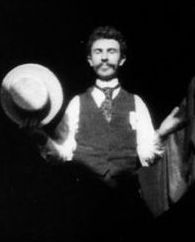Thomas Alva Edison (1848-1931, American) andWilliam Dickson (1860-1935, born French but multi-national) |
||
|
Inspired by his contemporaries, Edison conceived and patented his kinetoscope in 1888 but it was developed by Dickson, Edison's employee, between 1889 and 1892.
The kinetoscope was not a projecting device. it was a viewer which contained a strip of cellulose that moved over a light source. a 'gate' closed over the film as it advanced so the viewer only saw the complete frame over the light. A succession of still images with small changes, revealed quickly to the viewer in this way, produced the effect of a moving image. |
||
|
Thomas Edison by Louis Bachrach, Bachrach Studios |
To achieve this, Dickson split the existing 70 mm film (created by George Eastman) and added perforations, creating the 35mm film standard that has been used for video and still photography up until the digital age. Muybridge met Edison and proposed combining Edison's phonograph with his zoopraxiscope to produce a audio/visual experience but after registering a patient, Edison decided to make a silent version of the projector, his kinetograph. |
William Dickson |
|
Thomas Edison researched and brought together the ideas and concepts of the time to produce commercial opportunities. His knowledge of contemporary work in the field of photography and projection together with the work of his employee, Dickson was a force to be reckoned with. He did however, only hold patents in USA. |
||









